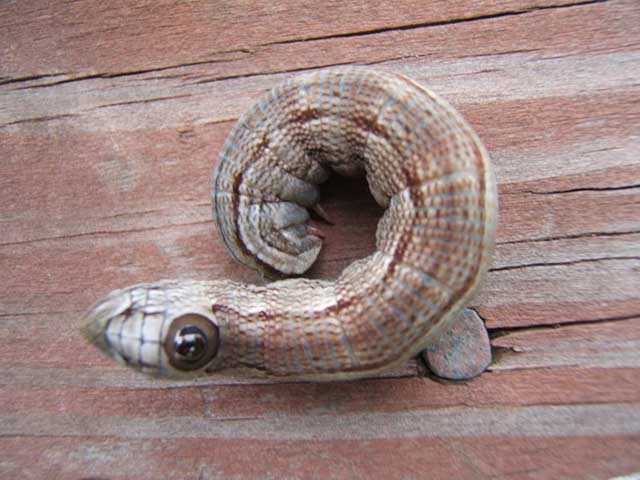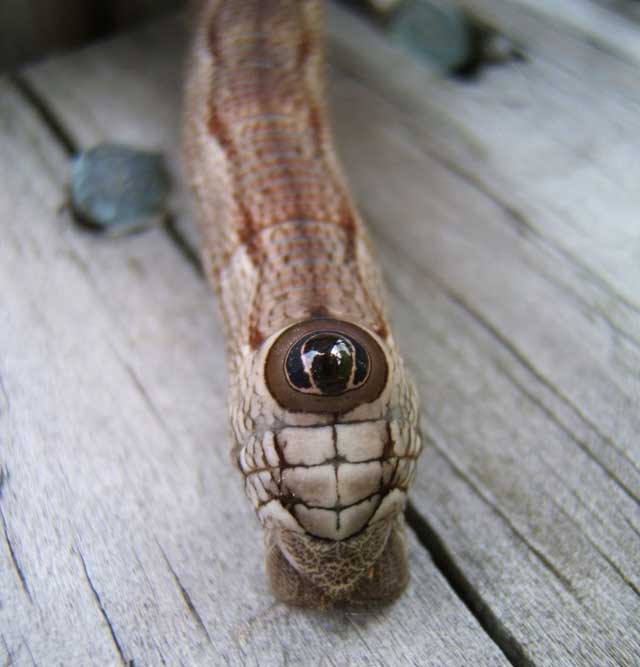Sphinginae subfamily
Sphingini tribe:
 |
Ceratomia amyntor
USGS/Dutchess,
the Elm Sphinx or Four-horned Sphinx
Caterpillars show both brown and green forms and are unmistakeable
due to four horns on the thorax (near the head).
Larvae feed on Elm (Ulmus), birch (Betula), basswood (Tilia), and
cherry (Prunus). |
 |
This caterpillar is one of the few North American Sphingidae that
feed in large groups. Colouration is distinctive.
The larvae
are much more spectacular than the moths.
Catalpa is the larval host. unlikely, northwestern range limit in NY
|
 |
Ceratomia undulosa
USGS/Dutchess/Schoharie, the Waved
Sphinx
Note the pinkish-orange tail, spiracles outlined in red and the cream
stripes on the head.
The dramatic color change from the dorsal
yellow-green to the lateral light greyish-blue is not always
as intense as in this image.
|
 |
Note the smooth skin, blue-black horn and small black spiracles.
Pawpaw is the primary host. Littleleaf sweetfern, possum haw,
inkberry, tall gallberry holly and others are also utilized.
|
 |
Lapara bombycoides
USGS/Colombia/Greene/Schoharie, the
Northern Pine Sphinx
This caterpillar is also without the anal horn and feeds on pines.
The long stripes and reddish brown afford great camouflage.
|
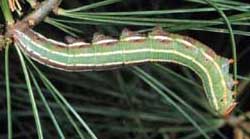 |
Lapara coniferarum
WO/Colombia, the Southern Pine Sphinx
This caterpillar is also without the anal horn and feeds on pines.
The long stripes and reddish brown afford great camouflage.
unlikely, northwestern range limit in NY
|
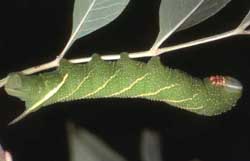 |
Larvae feed on ash in the Fraxinus genus. Syringa and Ulmus have
also been reported.
Note the black anal horn. unlikely, northwestern range limit in NY
|
 |
Manduca quinquemaculatus
WO,
the Five-spotted Hawkmoth
Note the solid black horn and dark spiracular rings. In addition to the white
oblique lines, there are fainter white rings, especially on the back.
I suspect if you grow tomatoes, you are likely to encounter it.
|
 |
Manduca sexta
WO/Colombia, the Carolina Sphinx
Note the red horn and black dots anterior to the white oblique lines.
If you grow tomatoes, you have probably encountered it.
|
 | Larvae feed at night, hiding on the underside of stems during the
day. Preferred hosts are common trumpetcreeper (Campsis radicans),
Florida yellow-trumpet (Tecoma stans), lilac
(Syringa species), and passionflower (Passiflora species).
|
 |
Note triangular bump on the thorax.
Larval hosts are various species of beebalm (Monarda), mints (Mentha), bugleweed (Lycopis),
and sage (Salvia).
|
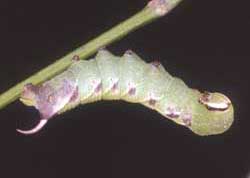
|
Sphinx canadensis
WO,
Sphinx canadensis, the Canadian Sphinx.
This species is not common at lights, and is not
often reported anywhere.
Larval host may be exclusively black ash (Fraxinus nigra).
Variable appearance but always with granulous (darker protrusions) on pinkish horn.
|
 |
Sphinx chersis
USGS/Schoharie,
the Northern Ash Sphinx or Great Ash Sphinx
Note pale blue horn and the creamy-white stripes on head.
The yellow form has a red horn.
Larval hosts are ash, lilac, privet, cherry and quaking aspen.
|
 |
Larvae hide in the day and feed primarily on cherry, plum, and apple
at night. Larvae have been found on Amelanchier nantuckensis
in Massachusetts and have been reared to pupation in Michigan on
Prunus serotina. Note purple oblique lines.
|
 |
Larval hosts are apple (Malus), sweetfern (Myrica),
Carolina rose (Rosa carolina), blueberry and huckleberry
(Vaccinium), white spruce (Picea glauca), American
larch (Larix laricina), and alder (Alnus).
|
 |
Sphinx kalmiae
USGS/Greene, the Laurel Sphinx
In the final instar, the black on the head, lateral lines, horn and on abdominal
legs is diagnostic. Larvae feed primarily on lilac and fringe.
|
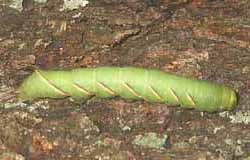 |
Sphinx luscitiosa
WO,
the Canadian Sphinx or
Clemen's Sphinx
This one is reported from Richmond and from northeastern New
Jersey into southern Canada.
|
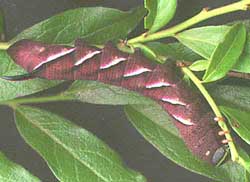 |
Sphinx poecila WO/Colombia, the Poecila Sphinx
If you have blueberries in the woods, then you probably have the
Poecila Sphinx.
The green form is more common.
|
Smerinthini Tribe:
 |
Amorpha juglandis larvae feed upon Walnut and butternut (Juglans),
hickory (Carya), alder (Alnus), beech (Fagus),
hazelnut (Corylus), and hop-hornbeam (Ostrya).
|
 |
Pachysphinx modesta
USGS/Colombia,
the Modest Sphinx or Poplar Sphinx
This moth is officially recorded in Delaware County. It is fond
of poplars and
willows.
|
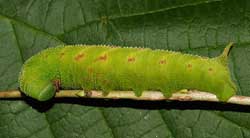 |
Blueberry and huckleberry (Vaccinium), cherries (Prunus) and
willows (Salix) are the favorites as larval foodplants.
unlikely, northwestern range limit in NY
|
 |
Paonias excaecata
USGS/Colombia/Dutchess,
the Blinded Sphinx
Larvae accept willows, birches, and cherries.
I have also found them in the wild on oak in eastern Canada.
|
 |
Paonias myops
USGS, the Small-eyed Sphinx
Wild cherry species are the favorites as larval foodplants, but eggs
will also be deposited on birches and other forest trees.
There are varying degrees in the amount of red markings along the sides.
|
 |
Smerinthus cerisyi
WO/Greene/Schoharie,
Cerisy's Sphinx;
Cerisyi larvae greatly resemble modesta larvae, both being pale
green, with granular skin, pale lateral diagonal lines, faint red
spiracular circles, and very pale longitudinal lines running from the
head to a more pronounced anal diagonal line.
Larvae have green heads bounded dorsally with a pale yellow
inverted "V".
|
 |
Larvae feed upon many forest trees including birches and cherries,
but are expecially fond of poplars and willows. Red markings on sides
vary greatly from specimen to specimen.
|
Macroglossinae subfamily
Dilophonotini tribe:
 |
Hemaris thysbe
USGS/Colombia/Dutchess, the Hummingbird Clearwing
There is also an orangey-pink prepupal form. The lateral line runs
from S1 to the blue horn.
Hemaris thysbe larvae feed on viburnum and related plants.
|
 |
Hemaris diffinis
USGS/Dutchess, the
Snowberry Clearwing or Bumblebee Moth
Larval host plants include Snowberry (Symphoricarpos),
honeysuckle (Lonicera), Coralberry, viburnums, Blue Dogbane
(Apocynum) and dwarf bush honeysuckle (Diervilla lonicera).
Horn is black with a yellow base.
|
 |
Hemaris gracilis
USGS, the
Slender Clearwing or Graceful Clearwing
Hemaris gracilis is distinguished from similar species by a pair of
red-brown bands on the undersides of the thorax, which varies from
green to yellow-green dorsally and sometimes brown with white
underneath. They have a red abdomen.
|
Philampelini tribe:
 |
Larvae feed upon Grape (Vitis), Virginia Creeper
(Parthenocissus quinquefolia) and other vines and ivies
(Ampelopsis).
Larvae occur in both a light (green) form and a darker (tan/brown)
form. Note six "segmented" oblique lines.
|
 |
If you have Grape or Virginia Creeper nearby, then you might encounter
this species. Note the five large white ovals. There are orangey-brown and green
forms also.
|
Macroglossini tribe:
 |
In additon to Virginia creeper larvae accept Grape (Vitis),
ampelopsis (Ampelopsis), and cayenne pepper (Capsicum).
Larvae are green until the final instar.
|
 |
Larvae feed on Azalea and Viburnum and progress very rapidly. The
larva to the left on Viburnum cassinoides is getting ready to
pupate. Color change from green to light burgundy-brown indicates
pupation is imminent.
|
 |
Darapsa myron
WO/Colombia/Schoharie, the Virginia Creeper Sphinx or the
Grapevine Sphinx
If you have the
foodplants indicated in the common names, you probably have this
species nearby. The lower wings are orange.
Larvae feed on Virginia creeper (Parthenocissus quinquefolia),
Grape (Vitis), Ampelopsis, and Viburnum.
|
 |
Larvae feed on Smooth hydrangea (Hydrangea arborescens),
buttonbush (Cephalanthus occidentalis), and waterwillow
(Decodon verticillatus).
Note small head which can be retracted into the thorax.
|
 |
Deidamia inscriptum
WO/Colombia/Schoharie,
the Lettered Sphinx
Grape (Vitis), ampelopsis (Ampelopsis), and
Virginia creeper (Parthenocissus) all serve as larval hosts.
The alternating yellow and greyish-green rings across the back
distinguish this larva.
|
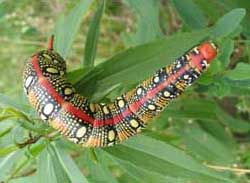 |
Hyles euphorbiae
Leafy Spurge Hawk Moth, Dutchess,
Larvae feed on leafy spurge. Larvae are also conspicuously colored, with a
pronounced tail or "horn" near rear end.
Young larvae are variously patterned with green, yellow, and black;
older larvae have distinctive red, black, yellow, and white color
pattern. Mature larvae may approach 10 cm in length; when disturbed,
they regurgitate a slimy green liquid.
|
 |
Hyles gallii
WO/Colombia/Dutchess/Greene/Schoharie,
the Bedstraw Hawk Moth
or Gallium Sphinx
Larvae come in black and in brown forms and often feed on
Epilobium (fireweed).
|
 |
Hyles lineata
USGS/Dutchess, the White-lined Sphinx
Larvae are highly varied and feed on a great diversity of plants
including willow weed (Epilobium), four o'clock (Mirabilis),
apple (Malus), evening primrose (Oenothera), elm
(Ulmus), grape (Vitis), tomato (Lycopersicon),
purslane (Portulaca), and Fuschia.
All larvae seem, however, to have the red/black swellings split by
dorso-lateral lines.
|
 |
Sphecodina abbottii
EM/Colombia/Dutchess,
the Abbott's Sphinx
Larvae feed at night on grape (Vitis) and ampelopsis
(Ampelopsis) and hide on the bark of their host plants during
the day. Virginia creeper would also be a suitable host. There is also a dark form
without the green patches. Note the "raised eye", replacing the anal horn.
|
|
|
